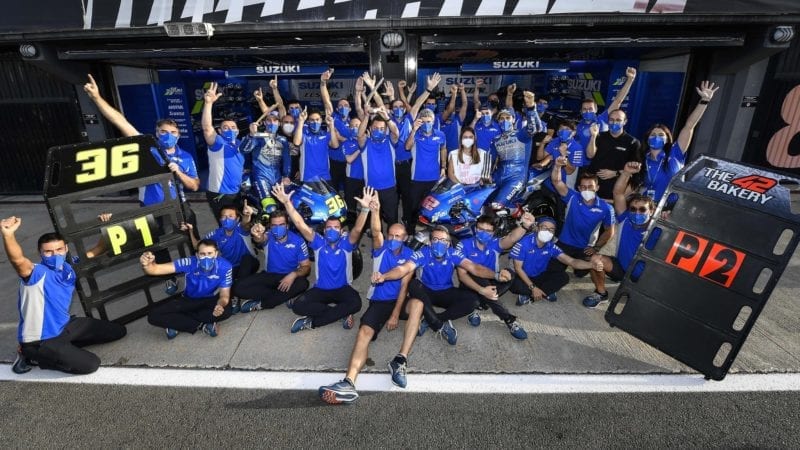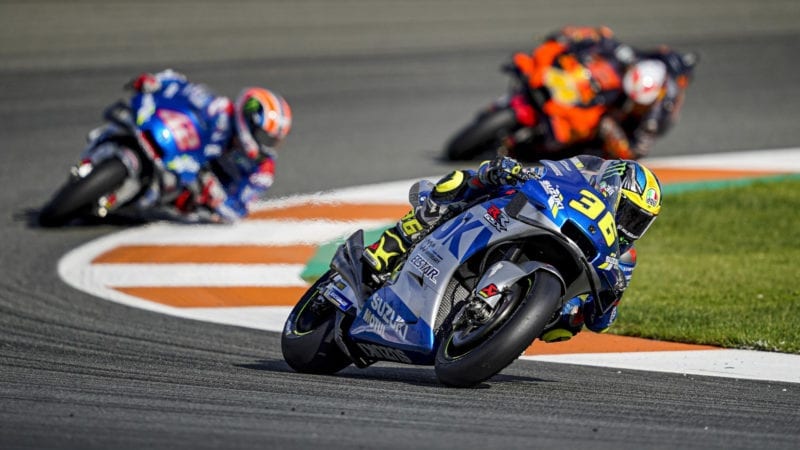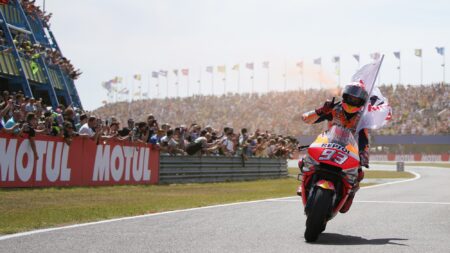So far this year Mir has scored eight podiums, just two fewer than the ten achieved by Yamaha’s four riders.
The GSX-RR’s friendliness also helps the bike look after its tyres. On Sunday Mir and Rins were the only top-ten finishers who ran the medium front instead of the hard. This gave them a significant advantage, because softer tyres give better feedback and therefore more warning of impending doom, so riders can feel exactly what’s going on at the tyre/track interface, which gives them the confidence to push to the very limit.
Meanwhile during Sunday’s race, almost a third of the grid (six of 21 riders) most likely didn’t feel the limit, so they tripped over it and crashed out. KTM’s Pol Espargaro, the only man who could run the pace of the Suzukis, used the hard front slick, because the RC16’s character demands a harder compound front. He had to be very careful how he managed the tyre – if he didn’t do it right he knew he would either crash or be too slow.
The extra feel the Suzuki gives also allows its riders to be more accurate, which helps explain Mir’s stunning consistency. From laps four to 25 he was between 1min 31.9sec and 1min 32.2sec on all but three laps!
It’s impossible to attribute any of these machine characteristics to any particular aspect of the Suzuki’s design. But from the very start of the GSX-R project the bike was designed to be a well-rounded machine, rather than a weapon that’s super strong in some areas and inevitably less so in others.
The most important word in motorcycle racing is compromise, because at the sky-high level of MotoGP it’s almost impossible to improve a bike in one area without hurting it in another. Therefore Suzuki technical manager Ken Kawauchi and his engineers have made the GSX-RR MotoGP’s king of compromise, carefully blending together each area of performance.
“Always we say that the most important thing is the balance of the bike,” says Kawauchi. “If we only increase horsepower it’s not ideal and if we only improve turning it’s not ideal. The most important thing is that we extended the bike’s ability in all areas from 2019 to 2020.”

Suzuki celebrates its first one-two since Hockenheim 1982
Suzuki
Since the GSX-RR did its first race in March 2015 Suzuki has carefully tweaked the bike, always working to find more race-long performance by refining the details, rather than looking for big performance gains here or there. You might say that the way Suzuki works and the way the GSX-RR works is the exact opposite of how Ducati and the Desmosedici work.
The GSX-RR’s only real handicap over the years has been a lack of horsepower. Year by year Suzuki has added a few horses here and there, only once taking a wrong turn. That was in 2017 when engineers at Hamamatsu increased crankshaft mass to improve corner-exit traction. In fact they went too far, so the bike was heavier to turn. That mistake finally convinced them that it’s better to keep taking small steps in the right direction than risking giant leaps.
Perhaps the final piece of the jigsaw is Michelin’s 2020 rear slick, which suits the inline-fours – the corner-speed bikes – better than it fits the V4s. The tyre’s grip allows Mir and Rins to carry more speed out of the corners, which gives the same benefit as a few extra horsepower, reducing the straight-line advantage of the V4s.
The bike’s overall strength and its ability to deal with Covid curveballs has put Mir and Rins first and third in the riders championship and Suzuki ahead in the constructors’ championship.
The last time Suzuki won the constructors crown was way back in 1982, when the factory ruled 500cc GP racing with its RG500 square-four two-stroke. Indeed the RG won the title seven years in a row, from 1976.
The RG is arguably the greatest machine in the history of GP racing, because it democratised the premier class for the first and last time. Suzuki equipped its official riders with factory RGs, but the bikes it sold to privateer riders often performed just as well. No wonder they were so popular – in 1977 all but four of the 32 points scorers in the 500cc world championship rode RG500s!




